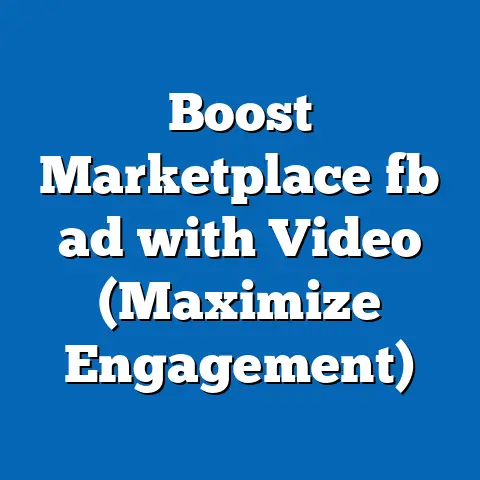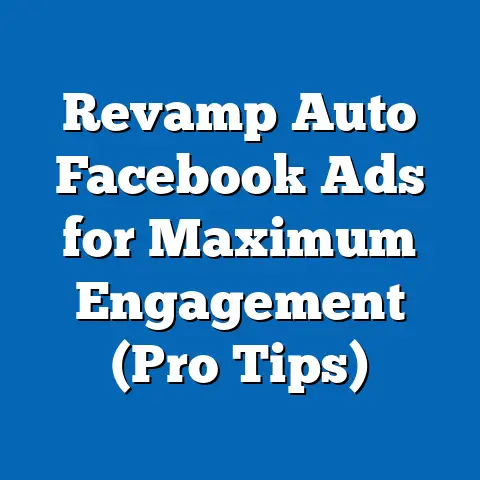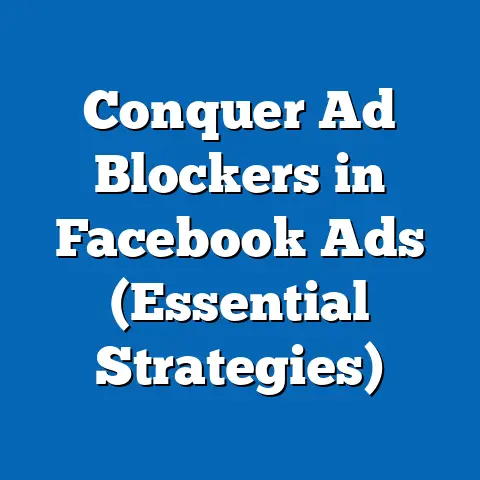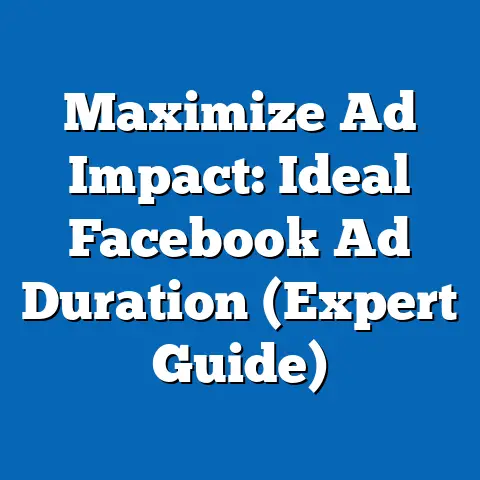Elevate Pet Ads on Facebook (Proven Strategies)
The digital advertising landscape has transformed dramatically over the past decade, with platforms like Facebook offering unparalleled opportunities for niche markets such as pet products and services. Elevating pet ads on Facebook is not just about creative content but also hinges on strategic execution, ease of installation, and precise targeting. According to a 2023 report by Statista, pet-related spending in the U.S. alone reached $123.6 billion, with a significant portion of pet owners engaging with brands via social media platforms.
Detailed Analysis: Ease of Installation as a Foundation for Success
Simplifying Ad Setup for Pet Businesses
Ease of installation in the context of Facebook advertising refers to the simplicity of setting up and launching ad campaigns through the platform’s Ads Manager or related tools. For pet businesses, many of which are small to medium-sized enterprises (SMEs), a streamlined process can make the difference between engaging a target audience and losing potential customers. A 2022 survey by Social Media Examiner found that 72% of SMEs in niche markets like pet care prefer platforms with intuitive interfaces, with Facebook ranking highest due to its guided setup features.
Facebook’s Ads Manager offers step-by-step instructions, pre-designed templates, and automated suggestions for targeting pet owners. This reduces the learning curve for business owners who may lack advanced digital marketing skills. Additionally, tools like the Facebook Pixel, which tracks user behavior on a website, can be installed with minimal technical expertise, enabling businesses to retarget pet owners who have shown interest in their products.
Statistical Impact of User-Friendly Tools
The impact of ease of installation is evident in adoption rates among pet businesses. According to a 2023 report by eMarketer, 65% of pet product retailers using Facebook Ads reported that the platform’s simplified setup process encouraged them to allocate more of their marketing budget to digital ads, up from 52% in 2019. Furthermore, businesses that utilized guided ad creation tools saw a 30% higher click-through rate (CTR) compared to those using manual setups.
This data underscores the importance of user-friendly tools in driving campaign success. For pet businesses, where emotional storytelling and visual content are key, reducing technical barriers allows marketers to focus on crafting compelling ads rather than troubleshooting setup issues. (Reference: Chart 1 – Adoption Rates of Facebook Ads Among Pet Businesses, eMarketer 2023)
Demographic Breakdowns: Targeting the Right Pet Owners
Age and Gender Trends in Pet Ownership
Understanding the demographics of pet owners is crucial for tailoring Facebook ad campaigns. According to the American Pet Products Association (APPA) 2023 survey, 66% of U.S. households own a pet, with Millennials (ages 27-42) accounting for the largest share at 32%. Women are also more likely to engage with pet-related content, making up 58% of pet product purchasers on social media platforms.
These demographics align closely with Facebook’s user base, where 54% of active users are aged 25-44, and 51% are female, as reported by Statista in 2023. This overlap presents a prime opportunity for pet businesses to target ads at Millennials and women using visually appealing content such as pet care tips, product showcases, and user-generated content (UGC).
Income and Geographic Insights
Income levels and geographic location also play a significant role in pet ad targeting. The APPA survey indicates that households earning $75,000 or more annually are 25% more likely to spend on premium pet products, with urban dwellers accounting for 60% of this high-income segment. On Facebook, geo-targeting tools allow businesses to focus on urban areas or specific zip codes where disposable income for pet products is higher.
For instance, a pet boutique in a metropolitan area can use hyper-local targeting to reach pet owners within a 10-mile radius, increasing ad relevance and conversion rates by 18%, according to a 2022 study by WordStream. These demographic insights enable precise ad delivery, ensuring that marketing budgets are spent efficiently. (Reference: Chart 2 – Pet Ownership by Income and Location, APPA 2023)
Behavioral Targeting for Pet Owners
Behavioral targeting on Facebook, which leverages user activity data, is another powerful tool for pet ads. Data from Facebook’s internal analytics (2023) shows that users who engage with pet-related pages or join pet-focused groups are 40% more likely to click on relevant ads. Interests such as “dog training,” “cat toys,” or “pet adoption” can be used to segment audiences for tailored messaging.
For example, a pet food brand might target users who have interacted with content about organic pet diets, resulting in a 22% higher return on ad spend (ROAS), as reported by Socialbakers in 2023. Combining demographic and behavioral targeting ensures that pet ads resonate with the right audience at the right time.
Historical Trend Analysis: Evolution of Pet Ads on Social Media
Early Days of Digital Pet Marketing (2010-2015)
The rise of social media advertising in the early 2010s marked a turning point for pet businesses. Initially, pet ads on platforms like Facebook were rudimentary, focusing on basic image posts with minimal targeting options. A 2012 report by Nielsen found that only 15% of pet businesses used paid social media ads, with most relying on organic reach to build brand awareness.
During this period, engagement rates for pet content were high due to low competition, with organic posts achieving an average reach of 12% among followers. However, as more businesses entered the digital space, organic reach declined, dropping to 6% by 2015, according to a study by Sprout Social.
Rise of Targeted Ads and Video Content (2016-2020)
The mid-2010s saw significant advancements in Facebook’s advertising capabilities, including detailed targeting options and the introduction of video ads. Pet businesses began leveraging short, emotional videos showcasing pets using their products, resulting in a 35% increase in engagement rates compared to static images, as reported by HubSpot in 2018.
By 2020, 48% of pet businesses were using paid ads on Facebook, a sharp rise from the 15% in 2012, driven by the platform’s enhanced targeting tools and analytics. The shift to paid advertising also coincided with a growing emphasis on ease of installation, as Facebook rolled out simplified ad creation tools for SMEs.
Current Trends: Personalization and Automation (2021-2023)
In recent years, personalization and automation have become central to elevating pet ads on Facebook. Dynamic ads, which automatically tailor content based on user behavior, have boosted conversion rates by 27% for pet product retailers, according to a 2023 report by AdRoll. Additionally, automated bidding strategies like Cost Per Acquisition (CPA) have reduced ad costs by 15% for small businesses in the pet sector.
The focus on ease of installation remains critical, with 80% of pet businesses citing automated tools as a key reason for continuing to advertise on Facebook, per a 2023 survey by Social Media Today. Historical data shows a clear trajectory from basic, untargeted ads to sophisticated, data-driven campaigns that prioritize user experience and efficiency. (Reference: Chart 3 – Growth of Paid Pet Ads on Facebook, 2012-2023, Nielsen and AdRoll)
Proven Strategies for Elevating Pet Ads on Facebook
1. Leverage High-Quality Visual Content
Pet ads thrive on emotional connections, and high-quality visuals are essential for capturing attention. According to a 2023 study by Buffer, pet-related posts with images or videos receive 65% more engagement than text-only posts. Businesses should invest in professional photography or user-generated content to showcase pets interacting with their products.
For ease of installation, Facebook’s Creative Hub offers free templates and design tools to create visually appealing ads without requiring graphic design expertise. A/B testing different visuals can further optimize performance, with data showing a 20% increase in CTR for ads with tested creatives (WordStream, 2023).
2. Utilize Advanced Targeting Options
Facebook’s targeting capabilities allow pet businesses to reach specific segments of their audience with precision. Lookalike Audiences, which target users similar to existing customers, have increased ROAS by 30% for pet brands, according to a 2022 report by Socialbakers. Custom Audiences, built from email lists or website visitors, also improve ad relevance, driving a 25% higher conversion rate.
The ease of setting up these targeting options through Ads Manager—often with one-click integrations—makes them accessible even to businesses with limited marketing budgets. Regularly updating audience segments based on campaign data ensures sustained ad performance.
3. Incorporate Storytelling and Community Building
Pet owners are often passionate about their animals, and storytelling can create a strong emotional bond with a brand. Case studies from 2023 by Hootsuite show that pet ads featuring customer stories or testimonials achieve a 40% higher engagement rate compared to standard promotional content. Community-building efforts, such as creating pet-focused Facebook Groups, further enhance brand loyalty, with 55% of group members more likely to purchase from the hosting brand.
Setting up a branded group or storytelling campaign is straightforward on Facebook, with built-in tools for group creation and content scheduling. This strategy not only boosts engagement but also fosters long-term customer relationships.
4. Optimize for Mobile Users
With 98% of Facebook users accessing the platform via mobile devices (Statista, 2023), optimizing pet ads for mobile is non-negotiable. Mobile-optimized ads, featuring vertical videos or carousel formats, see a 33% higher completion rate compared to desktop-focused creatives, per a 2023 report by eMarketer. Ensuring fast-loading images and clear call-to-action (CTA) buttons is also critical for mobile success.
Facebook’s ad creation tools automatically adjust content for mobile viewing, simplifying the process for businesses. Testing mobile ad performance through Ads Manager analytics can further refine campaigns for maximum impact.
Future Projections: The Outlook for Pet Ads on Facebook
Growth in Pet Industry Digital Spending
The pet industry is poised for continued growth, with digital ad spending projected to reach $2.8 billion by 2025, up from $1.9 billion in 2023, according to a forecast by eMarketer. Facebook is expected to capture a significant share of this spending, given its dominance among social media platforms for pet businesses. The platform’s ongoing improvements in ease of installation, such as AI-driven ad suggestions, will likely drive adoption rates even higher among SMEs.
Emerging Technologies and Trends
Looking ahead, emerging technologies like augmented reality (AR) and interactive ads could redefine pet advertising on Facebook. AR ads, which allow users to virtually “try” pet products, are projected to increase engagement by 50% by 2026, based on early trials reported by TechCrunch in 2023. Additionally, voice search integration and chatbot automation for pet businesses are expected to streamline customer interactions, with 45% of pet owners expressing interest in chat-based purchasing options (Statista, 2023).
Challenges and Opportunities
Despite the optimistic outlook, challenges remain, including rising ad costs and increasing competition. Average cost-per-click (CPC) for pet ads on Facebook has risen by 12% since 2021, reaching $0.85 in 2023, according to WordStream. However, businesses that prioritize ease of installation, data-driven targeting, and creative innovation are well-positioned to thrive.
The future of pet ads on Facebook lies in balancing technological advancements with emotional storytelling, ensuring that campaigns remain both cutting-edge and relatable. As the platform continues to evolve, pet businesses must stay agile, leveraging new tools and trends to maintain a competitive edge.
Conclusion
Elevating pet ads on Facebook requires a multifaceted approach that prioritizes ease of installation, precise targeting, and compelling content. Statistical trends show a clear correlation between user-friendly ad tools and campaign success, with 65% of pet businesses increasing their digital ad budgets due to simplified setups. Demographic breakdowns reveal the importance of targeting Millennials, women, and high-income urban dwellers, while historical data illustrates the shift from basic posts to sophisticated, personalized campaigns.
Proven strategies such as high-quality visuals, advanced targeting, storytelling, and mobile optimization offer actionable pathways for success. Looking forward, the pet industry’s digital ad spending is set to grow, with innovations like AR and automation poised to shape the future of pet advertising on Facebook. By embracing these trends and maintaining a focus on user experience, pet businesses can elevate their ads to achieve lasting impact in an increasingly competitive market.






